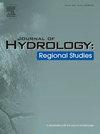Method for identifying non-stationary hydrological drought in regions with intense human activities
IF 4.7
2区 地球科学
Q1 WATER RESOURCES
引用次数: 0
Abstract
Study region
the middle reaches of the Yellow River Basin (MYRB).
Study focus
In regions with intense human activities, the stationarity of runoff sequences was disrupted due to the dual impacts of climate changing and human activities. Therefore, establishment of non-stationary hydrological drought identification methods is urgently required. Previous research infrequently addressed the influence of indirect human activities on the non-stationary hydrological drought. This study comprehensively considered the impacts of climate change, direct human activities, and indirect human activities (underlying surface alterations) on runoff. Consequently, a non-stationary standardized runoff index (NSRI) was constructed based on the Generalized Additive Models for Location, Scale, and Shape, establishing a method for identifying non-stationary hydrological droughts in regions with intense human activities.
New hydrological insights for the region
This study uncovered the variability in hydrological drought characteristics in the major sub-basins of the MYRB, where human activities are intense, from 1960–2019.The results demonstrate that the non-stationary hydrological drought identification method constructed in this paper is feasible. The NSRI exhibits superior performance in identifying hydrological drought events across multiple timescales compared with the Standardized Runoff Index. In many sub-basins, the frequency of severe and extreme droughts across various time scales increased, with upward trends measured in both drought severity and intensity. The severity of hydrological drought in the MYRB may further intensify in the future.
求助全文
约1分钟内获得全文
求助全文
来源期刊

Journal of Hydrology-Regional Studies
Earth and Planetary Sciences-Earth and Planetary Sciences (miscellaneous)
CiteScore
6.70
自引率
8.50%
发文量
284
审稿时长
60 days
期刊介绍:
Journal of Hydrology: Regional Studies publishes original research papers enhancing the science of hydrology and aiming at region-specific problems, past and future conditions, analysis, review and solutions. The journal particularly welcomes research papers that deliver new insights into region-specific hydrological processes and responses to changing conditions, as well as contributions that incorporate interdisciplinarity and translational science.
 求助内容:
求助内容: 应助结果提醒方式:
应助结果提醒方式:


